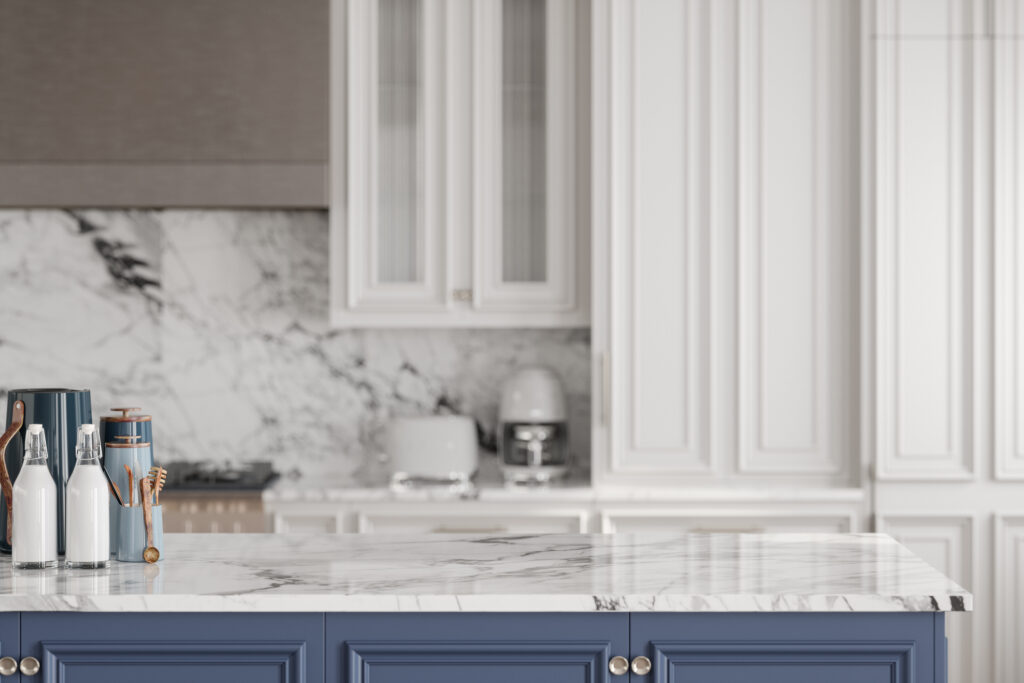13 Kitchen Island FAQs

Are you thinking about adding an island to your kitchen? This wise investment provides more countertop and storage space, but it requires careful planning to achieve the desired results. Learn the answers to 13 of the most frequently asked questions for a head start on designing an amazing and functional island.
1. What Is a Kitchen Island?
A kitchen island is a freestanding workspace in a kitchen, accessible from all sides. This differs from a peninsula, which is attached along one edge to cabinetry or a wall. Islands often include seating, extra storage, or even sinks, dishwashers, and cooktops.
2. How Much Space Do You Need for a Kitchen Island?
When you plan your kitchen, consider the space you have to work with. Walkways around the island should be at least 36 inches wide, so that’s the minimum distance the island should be from surrounding cabinets. Spaces in front of large appliances like the dishwasher, oven, and fridge need extra room. Measure how far the doors swing open, and plan your island clearance accordingly.
3. How Big Should I Make My Kitchen Island?
There isn’t a standard dimension, but widths usually range from 24 to 48 inches, and lengths often run 4 to 7 feet. In larger kitchens, feel free to supersize the island to 8, 9, or even 10 feet long. Just be careful not to make the island too big. If you can’t reach more than halfway across from at least one side, the center becomes difficult to clean. The goal is to scale the island to fit the room and support good traffic flow.
4. How High Is a Kitchen Island?
Standard countertop height is 36 inches. If you include seating, be sure to find “counter-height” stools with a seat height of 24 to 26 inches. If you want a bar-height section, the counter will sit 42 inches above the floor. In this case, you’ll need taller “bar-height” stools, with seats roughly 29 to 32 inches tall.
5. How Much Overhang Is Needed for Kitchen Island Seating?
To make room for each stool and the seated person’s knees, plan for an overhang of about 12 to 15 inches. Be aware that you may need support brackets, corbels, or columns for safety.
6. How Is a Kitchen Island Secured to the Floor?
Even though islands appear freestanding, they are anchored to the floor. Installers use cleats, brackets, or framing to tie into the subfloor. When sinks, cooktops, or plumbing are installed in the island, even more structural support may be required.
7. Does the Island Have to Match the Rest of the Cabinets?
Matching cabinets throughout the kitchen creates unity and a clean design, but it isn’t necessary. In fact, many designers recommend intentional contrast to help the island stand out. So if you want to add an island without replacing all your cabinets and countertops, that’s certainly an option.
8. How Hard Is It to Install a Sink or Cooktop on a Kitchen Island?
Installing a sink or cooktop makes your island more functional. When done right, it looks professional and performs well. Just be prepared to add plumbing, wiring, or venting. Cutouts for sinks and cooktops must also be precisely measured and cut to avoid a sloppy appearance.
9. Do Kitchen Islands Need Outlets?
Yes, most kitchen islands require outlets under the current National Electrical Code (NEC) standards. The rules generally require an outlet for every 9 feet of continuous countertop run. This means even a modest island will usually need at least one receptacle, and longer islands often need two or more.
You can install outlets in different ways. Many homeowners prefer side-mounted receptacles on the cabinet base. Others opt for pop-up or in-counter receptacle assemblies that stay hidden until needed. If you opt for outlets in the cabinet base, they must be placed within 12 inches of the countertop surface—unless the overhang is more than 6 inches. In this case, the outlet must be relocated to a side wall, front edge, or closer to the floor.
10. Do Kitchen Island Outlets Need to Be GFCI?
A ground fault circuit interrupter (GFCI) shuts off power if it detects electrical current flowing where it shouldn’t, which prevents shock hazards. GFCI protection is required for outlets that serve countertops, including those on a kitchen island. If your island has a sink, GFCI protection is mandatory. Even if no water source is nearby, adding GFCI protection is a worthwhile safety upgrade.
11. How Do You Light a Kitchen Island?
Pendants above the island are a popular way to deliver focused task lighting while adding a decorative element. Set pendants 30 to 36 inches above the countertop surface. Ensure even spacing to prevent casting shadows. Also consider recessed lighting around the perimeter of the kitchen and toe-kick lighting for additional ambiance.
12. How Do You Organize a Kitchen Island?
Island storage can be customized to fit your needs. Keep one side open for seating and dedicate the opposite side to deep drawers, sliding shelves, or pull-outs for easy access. Add visual appeal and additional storage with bookshelves, a towel bar, or a wine rack on one or both ends. Other ideas include a tilt-out trash bin, external spice rack, or built-in pet feeding station.
13. Do Kitchen Islands Add Home Value?
When designed well, islands often increase resale value. Buyers appreciate the added workspace, storage, and seating. You’ll see the strongest return on investment if the island features premium surface materials like granite, quartz, or marble.
Design Your Dream Island Today
Signature Marble and Granite serves Springville and the broader Northern Utah area with precision-crafted countertops for kitchen islands. When you work with us, you join the design team, shaping the details like slab dimensions, veining, and edge profiles. We explain every step, complete work the right way, and make the experience pleasant and affordable. If you’re planning a new kitchen island or upgrading your existing countertops, please contact us today for a countertop installation estimate.
